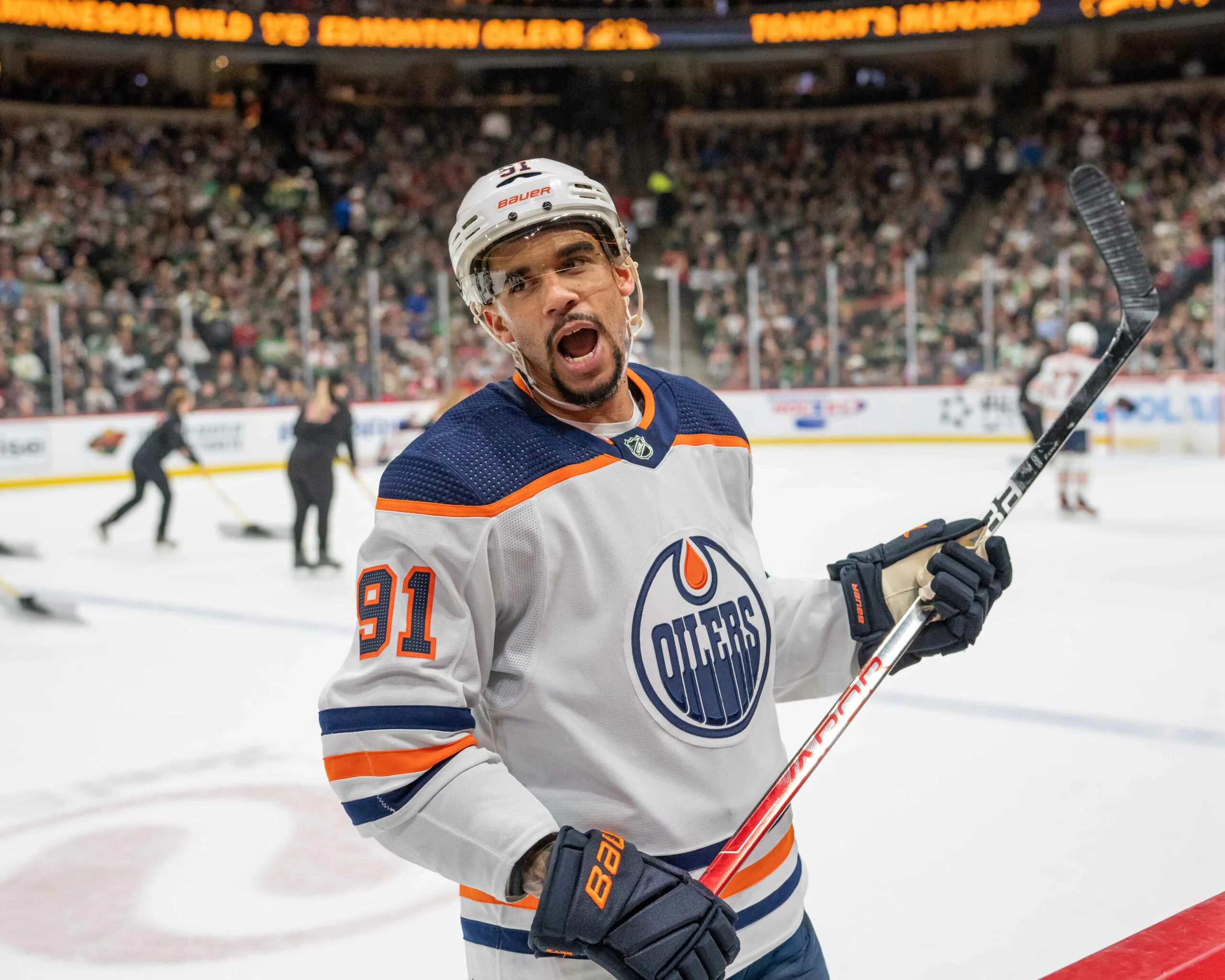Nation Sites
The Nation Network
OilersNation has no direct affiliation to the Edmonton Oilers, Oilers Entertainment Group, NHL, or NHLPA
The Oilers won’t miss Evander Kane in the lineup

Photo credit: Matt Blewett-USA TODAY Sports
Sep 26, 2024, 16:00 EDTUpdated: Sep 26, 2024, 14:25 EDT
Evander Kane is a great example of an NHL player whose perceived value doesn’t quite match with their actual value. A few days ago, Jason Gregor wrote about why he believes the team will miss Kane in the lineup. I want to look at the other side of the coin.
The 33-year-old forward is out for an extended period after undergoing major surgery this week. He’s on the third year of a four-year contract that he signed with Edmonton in 2022. Kane has played 930 games over his career, putting up 617 points, and has also appeared in 76 playoff games. Since being drafted fourth overall in the 2009 entry draft, Kane has established himself as a power-forward type with a blend of skill and physicality.
The issue for Kane is that while he does have this unique skillset, it hasn’t translated to positive on-ice results for him and the Edmonton Oilers. In the two seasons since signing a four-year deal with Edmonton (that pays him $5.125 million per year), Kane has posted a negative on-ice goal-differential at even-strength. And that’s been in the regular season and in the playoffs. These results are largely driven by the fact that when he’s on the ice, the Oilers tend to get outshot and outchanced.

When Kane did arrive in Edmonton in the middle of the 2021-22 season, he did go on an excellent individual run. And it’s what I think people remember most about him when assessing his career and impact as an Oiler. In 43 regular season games that year, Kane posted 22 goals and 17 assists, for 39 points. In the ensuing playoff run, when the Oilers went to the Western Conference Finals, Kane scored 13 goals and had four assists in 15 games. Great results, and excellent value for a player who was rebuilding his career and signed with Edmonton on a one-year, prorated deal. The one caveat with this season is that he played a lot with McDavid and Draisaitl, and his on-ice PDO (which combines his on-ice shooting and save percentages) was higher than expected ranges (over 103). A general manager who understands aging curves and regression analysis probably wouldn’t have signed Kane to a heavy, long-term deal. But I digress.
Back to Kane. After the 2021-22 season, and signing that long-term deal, a combination of age and injuries have really limited his ability to have a positive impact, especially at even-strength (5v5).
Below are Kane’s points-per-hour rates at even-strength (5v5) by season, over the course of his career. Last regular season, Kane finished with 15 goals and 15 assists in about 1,100 minutes of ice-time, which translates to a rate of 1.62 per hour. That’s well below where he’s been the previous few seasons – part of a declining trend – and closer to a third-line scoring rate. In the two years prior to that in Edmonton, he was around 2.00 points per hour, which is closer to a top line rate.

The issue with Kane is that while he can put up goals and points, he’s also been on the ice for a lot of goals against.
For instance, in the 2022-23 regular season, Kane played in 41 games and had 14 goals at even-strength. But he posted a -6 on-ice goal differential – one of the worst among the Oiler forwards as we see in the table below. The team did a much better job controlling the flow of play and generating opportunities without him deployed. And anyone playing with him often saw their on-ice shot-share numbers take a hit. Again, there’s the aging curves to factor in and the injuries he’s dealt with. But as I’ve written in the past, this type of negative on-ice impact was happening more frequently even before he arrived in Edmonton.

Kane’s performance numbers and results carried over into the 2023 playoffs where they were eliminated in the second round by the Vegas Golden Knights. He saw the most ice time among forwards during that playoff run, but again the Oilers were typically outshot when he was on the ice, and his -4 on-ice goal differential was one of the worst on the team.

In the 2023-24 regular season, Kane played 77 games and had 15 goals – fifth highest among the forwards. He continued getting plenty of opportunities, but again posted poor on-ice shot differentials at even-strength, and finished with a -1 on-ice goal differential. His numbers stood out in a bad way again as the rest of the Oiler forwards were well above where he was in terms of shot-share and goal-share. Yes, there were injuries he was dealing with. But why not take him out of the lineup then and help him recover, rather than have him drag the performance numbers and results of his team down?

And below is how the Oilers forward performed in the 2024 playoff run that took them to the finals. Kane again was below the team’s shot-share and goal-share levels, indicating that he didn’t have as great of an impact as perceived. Playoffs is when you would expect a skill, physical forward to really thrive. But that really wasn’t the case, as indicated by his performance numbers and results.

Thoughts
While Kane does have a strong reputation for being a skilled player who can play a physical style, his unique skill set has not translated into on-ice results for the Edmonton Oilers. The first two years of the four-year term he signed with Edmonton have not gone well, and you can argue that his contract is of poor value to Edmonton. Regardless of it’s regular season or playoffs, Kane’s on-ice numbers are typically poor relative to his teammates, and he doesn’t have the same impact on the game as he used to. The Oilers should have been aware of his declining value a long time ago and addressed the issue to have more flexibility with their roster and cap situation. Instead, the Oilers are on the hook for two more years at over $5 million, and can’t realistically expect Kane to return to top form after undergoing major surgery.
Data: Natural Stat Trick, Puckpedia
SPONSORED BY bet365
Breaking News
- Analyzing the Oilers’ goalie trade and a scouting report on Spencer Stastney
- Bowman: Backup Calvin Pickard ‘will remain with the team’ after Skinner-Jarry trade
- ‘It was time for something different’: Career consistency drew Stan Bowman, Oilers to Tristan Jarry
- From ‘can we please get rid of Bowman’ to ‘good trade,’ fans mixed on Oilers’ Skinner for Jarry trade
- Oilers recall Riley Stillman from AHL Condors
